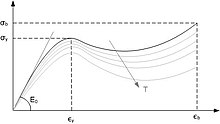A thermoplastic is a type of plastic polymer that becomes pliable or moldable at a certain elevated temperature and solidifies upon cooling. Most thermoplastics have a high molecular weight, and their polymer chains weaken rapidly with increased temperature, yielding a viscous liquid.
In this state, thermoplastics may be reshaped and are typically used to produce parts by various polymer processing techniques such as injection molding, compression molding, calendering, and extrusion.
Unlike thermosetting polymers, thermoplastics do not form irreversible chemical bonds during the curing process, allowing them to be molded repeatedly without undergoing a chemical change in their composition when heated.
Some examples of thermoplastics include polyethylene (PE), polypropylene (PP), polystyrene (PS), and polyvinyl chloride (PVC).
Thermoplastic elastomers (TPE), sometimes referred to as thermoplastic rubbers (TPR), are a class of copolymers or a physical mix of polymers that consist of materials with both rubbery and plastic properties.
They are relatively easy to use in manufacturing, for example, by injection molding, and possess the ability to stretch to moderate elongations and return to their near original shape. Examples of TPE materials include thermoplastic polyurethanes (TPU), thermoplastic vulcanizates (TPV), and thermoplastic olefin elastomers (TPO).
Short fiber thermoplastics are a type of thermoplastic containing short fiber reinforcements, which were first introduced commercially in the 1960s. They are able to withstand high tensile loads and have an elastic modulus suitable for applications where toughness is critical.
Short fiber reinforced thermoplastics are desired in industries such as electrical, electronics, automotive, oilfield, chemical process, and defense due to their performance capabilities, ease of processing, and cost-effectiveness[5].
In summary, thermoplastics are versatile materials that can be molded and reshaped at elevated temperatures, making them suitable for a wide range of industrial applications. Thermoplastic elastomers and short-fiber thermoplastics are specific types of thermoplastics with unique properties that make them valuable for various industries.
Citations:
[1] https://en.wikipedia.org/wiki/Thermoplastic
This article needs additional citations for verification. (March 2021) |
A thermoplastic, or thermosoftening plastic, is any plastic polymer material that becomes pliable or moldable at a certain elevated temperature and solidifies upon cooling.
Most thermoplastics have a high molecular weight. The polymer chains associate by intermolecular forces, which weaken rapidly with increased temperature, yielding a viscous liquid. In this state, thermoplastics may be reshaped, and are typically used to produce parts by various polymer processing techniques such as injection molding, compression molding, calendering, and extrusion. Thermoplastics differ from thermosetting polymers (or "thermosets"), which form irreversible chemical bonds during the curing process. Thermosets do not melt when heated, but typically decompose and do not reform upon cooling.

Above its glass transition temperature and below its melting point, the physical properties of a thermoplastic change drastically without an associated phase change. Some thermoplastics do not fully crystallize below the glass transition temperature, retaining some or all of their amorphous characteristics. Amorphous and semi-amorphous plastics are used when high optical clarity is necessary, as light is scattered strongly by crystallites larger than its wavelength. Amorphous and semi-amorphous plastics are less resistant to chemical attack and environmental stress cracking because they lack a crystalline structure.
Brittleness can be decreased with the addition of plasticizers, which increases the mobility of amorphous chain segments to effectively lower the glass transition temperature. Modification of the polymer through copolymerization or through the addition of non-reactive side chains to monomers before polymerization can also lower it. Before these techniques were employed, plastic automobile parts would often crack when exposed to cold temperatures. These are linear or slightly branched long chain molecules capable of repeatedly softening on heating and hardening on cooling.